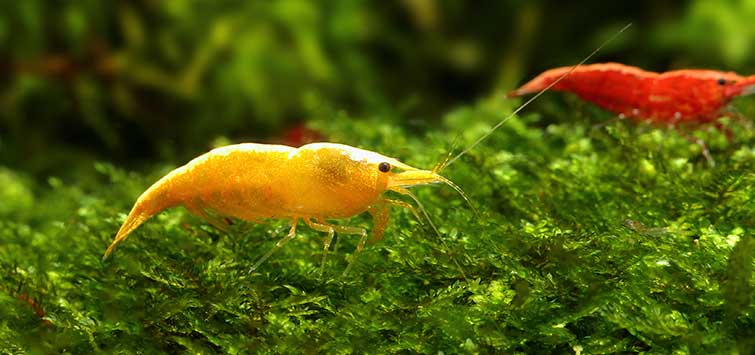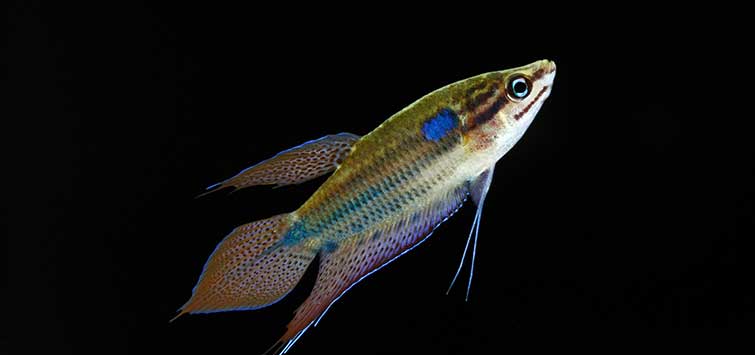The Tangerine-Head Crab: A Tree-Climber From Thailand
Author: Uwe Dost
An unusual newcomer that is easy to keep and breed, this tiny crab is sure to fascinate with its colorful appearance and accomplished climbing abilities. A crustacean aficionado shares his experiences keeping this vibrant species, reporting on its preferred climates, feeding habits, and mating practices.
Diverse Species of Crabs
There are a great many species of crabs. The majority of them live in the sea, some live in fresh water, and a few live on land. Most get quite large, many are quite aggressive, and they are not able to be bred in an aquarium or paludarium, so most are not suitable for your system. Fortunately a few species are perfect for a paludarium.
The first land crabs of the genus Geosesarma—the vampire and tangerine crabs—appeared in the trade in 2006. Both species are still offered under their trade name, or as simply Geosesarma sp. Their exact scientific identification and data of their biotopes remain unknown.
Newcomer
At the end of 2007, a new species of land crab appeared in the pet trade: the tangerine-head crab, otherwise called the red tomato crab. In contrast to the two species originally listed, the tangerine-head crab is a scientifically well-determined species with a well-known origin. Labeled as Geosesarma krathing Ng and Naiyanetr 1992, it originates from eastern Thailand.
During my search for more information on this species, I came upon some websites that not only offered further data, but even pictures of the crabs and their biotopes/living spaces. I also found mention of the national park Khao Khichakut, situated around 30 kilometers (20 miles) north of the town Chanthaburi. This national park is well known for its rich wildlife, and it even features a waterfall—the Krathing. The origin of the species’ scientific name was still a mystery to me, however—was the crab named after the person who discovered the waterfall, or were the crabs simply given that name because they lived close to it? I didn’t have the answer yet.
Since I had successfully kept and bred the vampire and tangerine crabs, I could not resist obtaining krathing when I saw them at a shop. Like the vampires and tangerines, this species also remains relatively small.
Natural Living Space
According to Raungprataungsuk et al. (2006), these pretty little crabs originate from east Thailand in the Chanthaburi Province, located about 220 kilometers (130 miles) east of Bangkok near the Cambodian border. Geosesarma krathing lives at and near the bank of this province’s main river. They are typically referred to as tree-climbing crabs due to their ability to climb bushes and trees along the riverbank. I found some pictures on the Internet that show the crabs resting on leaves or climbing branches, and in one nighttime shot, a man is walking through the vegetation of a riverbank with a flashlight—and right in front of him is a krathing crab sitting on a large leaf. Other pictures, taken during the daytime, show the crabs trying to hide under pieces of wood, branches, and dry leaves on the ground. Raungprataungsuk and his team members counted up to seven specimens per square meter during their study there.
In total, the team found and studied 289 specimens. They measured between 0.4 and 1.3 cm, with the females being slightly larger than the males. Smaller specimens were found living closer to the water. The size of the largest one I have seen yet measures around 1.6 cm, but specimens of up to 2.5 cm (and even 4 cm) can be found on the Internet. I have kept this species now for over a year, and several moltings later, I doubt that the species reaches beyond 2 cm (¾ inch).
Climate
To estimate the prevailing conditions, I checked MÜller’s 1996 Handbuch ausgewÄhlter Klimastationen der Erde (Handbook of Selected Climate Stations of the Earth) as I always do before I set up a terrarium for a new species. No climates were listed for the exact area where the crab originated from, but there was data for a region close by, near the town of Batdambang in Cambodia.
The temperatures range between 13.3° and 40.5°C (55.9° and 104.9°F) there, but these extreme temperatures should not be duplicated in the terrarium if the crabs are to be successful. Instead, a better range would be between 18° and 26°C (64° and 79°F). Knowing they can tolerate a wide temperature range is comforting, however, in light of the possibility that some of my equipment could fail; if the timer for my lighting unit or the controller for my heating pad malfunctions and causes a temperature swing, the crabs would still be okay.
If we examine the distribution of the area’s rainfall over the year, we will see that January and February are pretty dry. From March onward the rainfall increases, and the period from May to July/August constitutes a mild rainy season. At the end of August, the rainfall increases again and continues up to the end of October, which constitutes the main rainy season. The rain decreases notably at the beginning of November, and December is especially dry. Being riverbank inhabitants, the crabs are more at risk from rising water levels and flooding during the rainy seasons than from falling water levels in the dry periods of the beginning and end of the year.
Feeding
The short English summary on diet offered by Raungprataungsuk et al. was particularly helpful. The following was found in the stomach of the crabs: 77 percent soil/substrate, 13 percent wood, 6 percent leaves, 3 percent roots, and 1 percent insect and flower pieces. Obviously, soil and plant parts formed the majority of their diet, but I couldn’t tell if the composition of their diet changed throughout the year. Based on my observations, however, the tangerine-head crab seemed to prefer feeding on decomposing material, similar to fiddler crabs.
Being detritus lovers, they preferred to pick up tiny particles with their claws instead of grasping larger pieces to take back to their hiding place. Besides detritus, they also took all kinds of small fish food, such as spirulina or powdered flake foods. In contrast, the vampire crabs preferred bigger prey, such as crickets, catching them with their claws in quick fashion. They seemed to prefer a carnivorous diet that included bloodworms, worms, mussels, or prawn meat. Typically when crabs are given an established terrarium with decomposing leaves and microorganisms, they won’t have trouble finding something to eat. Thus, a crab tank should never be too clean or sterile.
Mating
According to Raungprataungsuk et al., females lay around 50 eggs. The reproduction period starts in January and lasts until April.
I bought my first Geosesarma krathing at the end of September. In my rainforest terrarium with a thick layer of leaves, the crabs are offered many hiding places, so it was difficult to see them all. They like to climb on Bromelia and hide in the spaces at the base of their leaves. Once or twice a week, I looked for females in the hopes that they carried eggs. On January 23, I finally found the first female carrying some eggs under her pleon (abdomen). In the middle of February, all three females had spawned and were carrying eggs. Geosesarma eggs are simply laid under the pleon and are not fixed with the pleopods (swimmerets) as with aquatic crayfishes.
Handling Females
You must therefore handle the females very cautiously, or they will lose many of their eggs. In the following weeks I examined the females periodically to see if the eggs would develop, but the dark, brownish color of the eggs didn’t change after eight weeks. I thought that maybe they weren’t fertilized, but they did appear fresh and well.
A Picture-Perfect Moment
On April 23, I found the first tiny baby crabs hiding under the shelter of their mother’s pleon. They were gray-colored and didn’t move, so I wasn’t sure if they were in good condition. I wanted to avoid handling the female crabs, but on the other hand, I wanted to take some pictures.
My patience eventually paid off, and on May 1 the first baby crawled over the rear of his mother. While I was taking some pictures, the female lost some of her babies. I ended up putting these carefully into a cricket box with a peat moss substrate, which I usually use for breeding Colembola to feed my dart frogs. The peat soil was covered with some leaves for shelter, which also doubled as food for the babies.
It was a good idea to place the tiny crawlers into a cricket box due to their ability to escape through even the smallest openings in the terrarium, e.g., in the space between the front doors. It also made feeding and photography much easier. I feed them with spirulina powder, powdered flake foods, and detritus. By May 15, only one baby had remained under the pleon of the first egg-carrying female. The babies didn’t seem to be in any hurry to leave the shelter of their mother. The two other females continued carrying their offspring around the terrarium as well, even weeks later.
Takeaways
In my experience, the tangerine-head crab is the most suitable species to maintain out of the three Geosesarma that have been introduced to the hobby. They are easy to keep and breed, and their young are not difficult to raise.
References
Dost, U. 2008. “Erste Erfahrung mit der Aufzucht der Mandarin und der Vampirkrabbe.” DATZ 61(3):72–73.
MÜller, M. J. 1996. Handbuch ausgewÄhlter Klimastationen der Erde. UniversitÄt Trier, Germany. 400 pp.
Raungprataungsuk, K., et al. 2006. “Preliminary study of biology and ecology of tree-climbing crab (Geosesarma krathing Ng and Naiyanetr 1992) (Crustacea: Brachyura: Grapsidae). The Proceedings of the 44th Kasetsart University Annual Conference 30 January–2 February 2006. Kasetsart University, Thailand. D
See the full article on TFH Digital http://www.tfhdigital.com/tfh/200906/#pg101

.png?h=595&iar=0&w=2781&hash=5FD5E69473BCC22199FBFA2FB71B6033)



